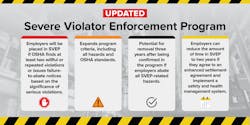Regulatory Update: OSHA Strengthens Severe Violator Enforcement Program
OSHA announced Sept. 15 that it will both strengthen enforcement and improve compliance with workplace safety standards in an effort to reduce worker injuries and illnesses. It will do this by, expanding the criteria for placement in the Occupational Safety and Health Administration’s Severe Violator Enforcement Program.
The new criteria include violations of all hazards and OSHA standards and will continue to focus on repeat offenders in all industries. Previously, an employer could be in the program for failing to meet a limited number of standards. The changes will broaden the program’s scope with the possibility that additional industries will fall within its parameters.
“The Severe Violator Enforcement Program empowers OSHA to sharpen its focus on employers who—even after receiving citations for exposing workers to hazardous conditions and serious dangers—fail to mitigate these hazards,” said Assistant Secretary for Occupational Safety and Health Doug Parker, in a statement.
Since 2010, the Severe Violator Enforcement Program has focused on enforcement and inspection resources on employers who either willfully or repeatedly violate federal health and safety laws or demonstrate a refusal to correct previous violations. In addition to being included on a public list of the nation’s severe violators, employers are subject to follow-up inspections.
Specifically, the updated criteria include the following:
- Program placement for employers with citations for at least two willful or repeated violations or who receive failure-to-abate notices based on the presence of high-gravity serious violations.
- Follow-up or referral inspections made one year – but not longer than two years – after the final order.
- Potential removal from the Severe Violator Enforcement Program three years after the date of receiving verification that the employer has abated all program-related hazards. In the past, removal could occur three years after the final order date.
- Employers’ ability to reduce time spent in the program to two years, if they consent to an enhanced settlement agreement that includes use of a safety and health management system with seven basic elements in OSHA’s Recommended Practices for Safety and Health Programs.
The updated program instruction replaces the 2010 instruction and remains in effect until canceled or superseded.

